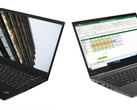Lenovo's ThinkPad line has been historically known for being full of sturdy, maintainable, and overall well-built business laptops, but there's a rather unusual problem just below the surface of that physical prowess. Since September of 2018, the community of ThinkPad users has been slowly bringing to light a problem with many of the line’s keyboards.
Dating back to machines from as early as 2011, certain ThinkPad models (notably T and X series laptops) will “scramble” keys when pressing them, turning something like “ASDF” into “FDSA.” People who hit faster typing speeds will notice this more often. For instance, you might not have much trouble with this on other laptops, but letters in your password sometimes get swapped around when using a ThinkPad. This has to do with the way these ThinkPad keyboards process key inputs, which is rather unconventional when compared to other laptops on the market.
Lenovo has been putting out BIOS/EC updates periodically for some of these units to try to fix this issue, but the results have been mixed. Some users report the issue is gone, while others just report that it only decreased the number of times the scrambling was happening. The issue for more recent ThinkPads is largely mitigated, but if you press ASDF at the same time on your keyboard, you will likely get something close to FDSA. The issue is still there, but it’s been minimized to where it’s hardly a problem anymore.
Around mid-August of this year, I was doing some research into the AMD-powered Lenovo ThinkPad T495 before buying one. I knew of this potential keyboard issue going into things, but the superior physical typing experience of the ThinkPad outweighed any potential funkiness for me. By the next week, I was setting this new laptop up. Once I got past the setup screen and started to install apps, I noticed something rather unexpected: noticeable keystroke latency.
Whenever I was typing in an application that introduced a bit of latency to the typing experience, such as Discord, that additional latency just amplified what was going on with the keyboard. It was slow enough where I could almost see the delay between the key press and the letter appearing on the screen. When I’d go to type messages to people via chat applications, or even just type emails, the number of mistakes I was making was a complete outlier from any experience I’ve ever had with a laptop. I gave it a fair chance, spending my time using it for a few days just to see if there was a mental break-in period with the longer key travel (I’ve historically only used laptops with rather shallow keystrokes), but time didn’t seem to improve my accuracy.
In early September, I just had to put the laptop away and spend most of my time typing on other machines. The number of corrections I was having to make to just get a message across was counter-productive, and nothing I could do was seeming to fix things. Typing anything on it was almost painful at times given the inconsistent behavior of the keyboard. I’d gone as far as trying to re-flash the BIOS and EC to see if that would fix it, but a corrupt image wasn’t my issue either.
The issue ended up being the same one the ThinkPad A485 and ThinkPad E485 were notably experiencing last year. Both are AMD-powered ThinkPads, and the A485 is essentially a Thinkpad T480 with a Ryzen processor. There was a widely reported issue on these where typing was very laggy and letters were getting switched around, and the symptoms they were talking about more accurately mirrored my issue than the all-at-once FDSA issue mentioned at the beginning of this article. On the official Lenovo product forums, a thread about the A485 and E485 keyboard issue had replies from this year from users with the ThinkPad E495 having the same problems. Keep in mind that while the E485’s keyboard issue was patched, the E495 was released with the same problem unpatched. It's also important to consider that the actual keyboard part on the T495 is the exact same one as on the Intel-powered ThinkPad T490.
Ultimately, this came down to BIOS updates. For the T495, it was fixed on November 3, 2019, with version 1.15. For the E495, this issue was fixed on October 23, 2019, with version 1.10. Each of these readme files reports that the new BIOS has “Improved keyboard function,” and I can attest to that. I can happily report that after updating my T495 to 1.15, the keyboard is no longer swapping and/or missing keystrokes entirely while typing. Typing in apps is no longer laggy, and overall the laptop feels faster.
If you’re not sure if your laptop has a similar issue to what these AMD ThinkPads have been experiencing as of late, here’s a quick and dirty way to test. First, open a basic writing application such as Notepad on Windows. Next, you can either attempt to quickly type “ASDF” or swipe your finger from A to F. If you can reliably type “FDSA” by swiping across “ASDF,” then you’re experiencing the same issue as many AMD ThinkPad users have been for the last few months. To try your hand at fixing this, check and make sure that your BIOS and drivers are up to date. If you have updates, check again after they complete to see if they fix the problem.
It’s important to note that AMD’s Ryzen mobile processors aren’t to blame for this problem. It likely has something to do with the changes Lenovo has had to make to the ThinkPad's motherboard for the Ryzen processors, not the processor itself. Unfortunately, a machine that released in May 2019 took until November of the same year to have a functional keyboard, but I'm happy that the manufacturer took the time to track down the problem and fix it. It's still mildly discouraging to see a patched issue from the last generation of ThinkPads crop up in the current generation, but it's always possible the issues are entirely different at a technical level.
I'm hoping Lenovo will break this forming pattern of keyboard trouble before it starts since I'd rather not see this turn into a pattern of defects similar to Apple's trouble with its butterfly keyboards. However, I'm mostly just happy I can use the keyboard on my T495 again.
Update: 11/17/2019 — fixed source links
Source(s)
Lenovo forum - Keyboard firmware scrambles keys on all T-series X-series
Reddit - ThinkPad keyboards measurement of polling lag
Reddit ThinkPad keyboard firmware worse than anyone could have expected
Lenovo forum - ThinkPad E495 Lagging and Unresponsive Keyboard
Lenovo forum - ThinkPad A485 keyboard typing issue
Lenovo forum - ThinkPad E485 strangely unresponsive keyboard
Reddit - ThinkPad A485 keyboard issue report
Reddit - ThinkPad A485 early adopters using linux please share your experience
Lenovo forum - ThinkPad A485 Keyboard Typing Issue
Lenovo forum - Theory on possible reason for ThinkPad keyboard issues
BIOS README files: T495 Bios 1.15 E495 Bios 1.10















